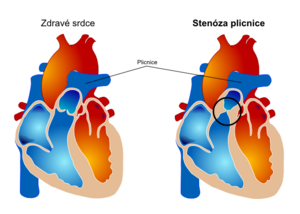Pulmonary stenosis
Pulmonary stenosis is a rare valvular defect in adult cardiology. [1] It can occur alone or as part of a more complex stenosis in the area of outflow tract of the right ventricle, meaning mainly the area of the lung. More generally, pulmonary stenosis refers to both pulmonary valve stenosis and subvalvular obstruction. Diagnosis is mainly based on echocardiographic examination, or examination by catheterization to assess pressures. [1]
Etiopathogenesis[edit | edit source]
The most common cause of vulvar pulmonary stenosis is a congenital heart defect, where valve stenosis is in most cases part of a complex heart defect such as tetralogy of Fallot or complete atresia of the outflow tract of the right ventricle.[2] However, it can also occur in isolation.
Pulmonary stenosis, as a valve defect, as also the most common type of stenosis in the outflow tract of the right ventricle, or lung. Pulmonary stenosis as a whole occurs in several forms depending on the location of stenosis. This can be located under the valve (narrowing of the infundibule of the right ventricle in tetralogy of Fallat or ventricular septal defect), in the place of the valve, above it or in the periphery of the branches of the pulmonary artery (again, it can be part of various congenital heart defects). Stenosis subsequently causes right ventricular hypertrophy, which can lead to its dilatation and the secondary development of tricuspid regurgitation and right-sided heart failure.[3]
Other possible etiologies of pulmonary stenosis are post-traumatic valvular involvement (rare) or carcinoid involvement, where the produced serotonin causes pulmonary valve fibrotization.[1] [2]
Clinical picture[edit | edit source]
An ascultatory finding is an ejection murmur over the pulmonary valve, or split of the second sound.[2] Patients may be asymptomatic, possibly experiencing nausea, shortness of breath, and chest tightness.[2] Critical stenosis in the newborn is life-threatening cyanotic heart defect ( due to right-left atrial shunting). At later age, children with less significant defects tend to have no problems, sometimes they have lower performance.[3]
Diagnostics[edit | edit source]
The ECG findings depend on the severity of the stenosis. The findings may be normal, but in more severe forms of stenosis, there are signs of right atrial overload, right ventricular hypertrophy and generally pathological changes in the right periodical leads (high QR, T wave inversion, etc.).[2]
Significant changes may not be visible on a chest X-ray. In newborns, with right-left atrial shunt and simultaneous involvement of the tricuspid valve, the right heart border is prominent. After that, the changes are mainly visible in the case of more severe degree of pulmonary stenosis, mainly in the sense of poststenotic expansion of the lung and enlargement of the right-sided compartments.[2]
Echocardiographic examination is the basic examination method of assessing anatomical abnormalities of the pulmonary valve and hemodynamic effects of the defect. The examination is not always simple, and it is necessary to assess the parameters of the tricuspid valve, including pressure gradients.[2] These can also be obtained by performing a right-sided catheterization, which is used to pressure gradients and other pulmonary stenosis.[1]
Treatment[edit | edit source]
The course is usually benign, e light defect does not require treatment.[3] In newborns, prostaglandin E1 is administered in some specific situations.[2] More severe stenosis can be treated by balloon valvuloplasty or, failing that, by cardiac surgery.[1] [2]
Links[edit | edit source]
Related articles[edit | edit source]
Used literature[edit | edit source]
- MANN, Douglas L, et al. Braunwald´s Heart Disease : A Textbook of Cardiovascular Medicine. 10th Edition edition. 2015. ISBN 978-0-323-29429-4.
- ČEŠKA, Richard, et al. Interna. 3. edition. Triton, 2020. ISBN 978-80-7553-782-9.
- BENEŠ, Jiří. Studijní materiály [online]. ©2009. [cit. 2009]. <http://jirben.wz.cz>.
References[edit | edit source]
- ↑ a b c d e ČEŠKA, Richard, et al. Interna. 3. edition. Triton, 2020. ISBN 978-80-7553-782-9.
- ↑ a b c d e f g h i MANN, Douglas L, et al. Braunwald´s Heart Disease : A Textbook of Cardiovascular Medicine. 10th Edition edition. 2015. ISBN 978-0-323-29429-4.
- ↑ a b c BENEŠ, Jiří. Studijní materiály [online]. ©2009. [cit. 2009]. <http://jirben.wz.cz>.

